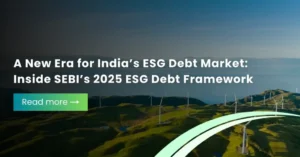Sustainable finance in India is entering a new phase, one...


Make a Sustainable Impact
Get Started with SAMESG®
With rising climate risks and an evolving ESG landscape, businesses are under increasing pressure to measure, manage, and disclose their greenhouse gas (GHG) emissions. Environmental footprint disclosures and alignment with frameworks like the ESRS, IFRS S2, and SEBI’s BRSR are no longer just compliance exercises, but are rather critical factors in building investor trust, long-term credibility, and sustainable growth.
As companies steer towards net zero, sustainability leaders are often confused with questions like where to begin, what are the emissions that need to be reported, and how.
The answer lies in understanding Scope 1, 2, and 3 emissions, as defined by the Greenhouse Gas Protocol (GHGP). These categories form the backbone of climate disclosure, helping organizations assess their direct and indirect (value chain) emissions.
In this blog, we’ll break down the what, why, and how of Scope 1, 2, and 3 emissions, and how smarter solutions can ease the process of reporting.
The Greenhouse Gas Protocol, the global standard for emissions accounting, divides emissions into three “scopes” to help companies track and reduce their environmental footprint effectively.
While Scope 1 and 2 reporting is increasingly common, Scope 3 remains a blind spot for many, despite accounting for 90% of emissions in most sectors, making it most critical to address it efficiently.
The categorization of greenhouse gas (GHG) emissions into Scope 1, 2, and 3 is a globally accepted framework that provides clarity, comparability, and strategic direction in emissions management. These distinctions are crucial for businesses and regulators for various reasons.
Each scope focusses on a different level of control and influence a company has over its emissions. Understanding this distinction helps businesses identify which emissions they can reduce through internal actions, and which require collaboration across suppliers, customers, and partners.
With the rise of mandatory climate disclosures under frameworks like GRI , IFRS S2 by ISSB and EU’s ESRS, companies are now expected to report across all three scopes, especially scope 3. These frameworks assess not just how the climate risk affects the business, but how the business affects the environment viz-a-viz climate change. Failing to distinguish and disclose emissions by scope can result in incomplete reporting, regulatory non-compliance, and reputational risk.
Investors and stakeholders consider GHG transparency as a sign of operational resilience and ethical governance. By accurately disclosing Scope 1, 2, and 3 emissions, businesses demonstrate that they:
In fact, as per a survey conducted in 2023 over 80% of institutional investors stated they expect companies to report Scope 3 emissions by 2025, and hence in the present scenario, its importance has grown more than ever.
Disaggregating emissions by scope allows for more focused reduction strategies. This would mean:
Without this categorization, emissions remain abstract, making it difficult to track down and take actions efficiently.
Accurate greenhouse gas (GHG) accounting begins with a clear understanding of how to measure and manage emissions across all three scopes. Each scope represents a different type of emissions responsibility, requiring a distinct approach to data collection, calculation, and reduction. Below is a practical, step-by-step guide for addressing Scope 1, Scope 2, and Scope 3 emissions.
Emissions from sources that are owned or directly controlled by the company, such as fuel combustion in company-owned vehicles, generators, boilers, and fugitive emissions from HVAC or refrigeration systems.
Emissions from the electricity, steam, heating, or cooling that the company purchases and consumes.
All other indirect emissions that occur outside the company’s direct operations — upstream and downstream including purchased goods and services, business travel, employee commuting, logistics, product use, and end-of-life treatment of sold products etc.
Building and maintaining a complete and credible emissions inventory is often more complex. The challenges are not just limited to data collection, but touch every part of the organization, from operations to supply chain. Here are some of the common challenges faced by organizations in measuring and managing GHG emissions.
Many companies struggle to access consistent, complete, and verified emissions data, as it involves tracking information across facilities, departments, or global operations. This is particularly true for Scope 3, where data often depends on suppliers or third-party partners.
Understanding how to apply emission factors, distinguish between scopes, or align with evolving reporting frameworks can be complex, especially in the absence of in-house sustainability expertise. Misinterpretations can lead to underreporting or inconsistent disclosures.
Without standardized approaches, companies often rely on assumptions and outdated models, leading to errors in calculations and difficulty in benchmarking performance across time or industry peers.
Scope 3 emissions often require cooperation from vendors, logistics providers, and other external actors. Limited transparency, lack of awareness, or unwillingness to share data can make the process difficult and time-consuming.
Developing robust systems for emissions tracking, scenario modeling, and reporting takes time, requires tools and experts and involves cost , small or early-stage companies may find it difficult to allocate.
As global standards evolve and ESG regulations become stricter, businesses are under pressure to adapt quickly. Ensuring disclosures remain compliant while also useful for internal decision-making can feel like a moving target.
SAMESG ® streamlines data collection from utility invoices, fuel logs, equipment meters, and more, then applies built-in emission factors automatically. This ensures accurate emissions calculations and creates audit-ready data, minimizing manual effort.
Scope 3 tracking, being considered the most complex, can be handled smartly with SAMESG ® as it supports supplier engagement through structured value-chain assessments, Tier 1 and 2 emissions tracking, and survey tools. It enables data-driven collaboration across your network.
From GRI and SASB to TCFD, BRSR, and ESRS, SAMESG ® is pre-configured to align and map your ESG data directly to major frameworks. It continuously updates with evolving regulatory requirements ensuring hassle-free compliance.
SAMESG consolidates data from diverse sources seamlessly into a single database, whether it’s direct data entry, Excel uploads, or automated extraction (including AI/ML extraction from PDFs and handwritten notes).
With SAMESG ® exportable disclosure reports can be generated (with minimal manual work. The built-in dashboards and analytics can be used to monitor trends, track KPIs, and gain actionable insights.
Understanding and managing Scope 1, 2, and 3 emissions is no longer optional but rather central to credible climate action and regulatory compliance. While the challenges of fragmented data, supplier dependencies, and shifting global standards can be overwhelming, they’re not impossible to overcome.
By investing in the right tools, like SAMESG ® organizations can simplify the process, ensure audit-ready accuracy, and drive real impact across their value chain.
With a world moving toward greater climate accountability, it’s time for businesses to move from intention to measurable action. Let’s grow responsibly, transparently, and sustainably.
Ready to simplify your emissions journey?
Explore how SAMESG can make Scope 1, 2, and 3 reporting easier, smarter, and fully compliant.
About the author

Director – Projects & Value Chain at SAM Corporate LLC
Follow the expert:
Rajagopal Kannan is the Director of Projects & Value Chain at SAM Corporate LLC, leading ESG, risk management, and sustainability initiatives. With over 20 years of experience, including a decade in banking and financial risk, he specializes in credit structuring, Basel II & III, ISO 31000, COSO ERM, internal audit, and regulatory compliance under CBUAE, DFSA, ADGM, and SCA.
His current focus lies in ESG integration, climate and sustainability risk management, and value chain sustainability. A GRI-certified Sustainability Professional and GARP-certified SCR holder, he also holds multiple global credentials including PRM®, GRCP, GRCA, CRCMP, CBiiiPro, CSM, and CISI Level 3.
Share
Related Posts
Explore more resources